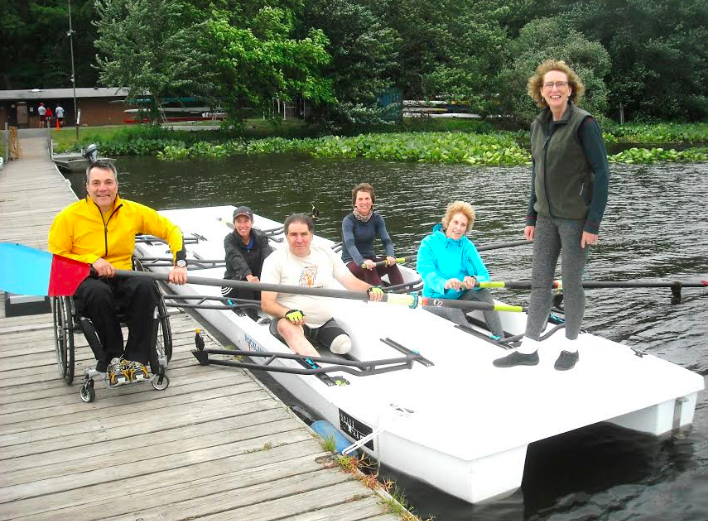
BY BARRY WARNER
According to the Census Bureau, an estimated 56.7 million people or 19-20 percent of the population in the United States, have a disability. Staying active while living with a disability can help people strengthen their hearts, build strong muscles and bones, improve coordination and make them feel better about themselves. For those with disabilities, there are many adaptive sports and recreation programs that can be enjoyed for health, wellness, leisure and social and competitive benefits.
Paddling sports include canoeing, kayaking, rafting and rowing. Modifications are made to each rowboat, canoe or kayak based on needs, making it easy to participate in those organizational activities. Simple adaptations may be needed for positioning and gripping to allow people of all abilities to participate in paddling sports together.
“Diana Costanzo is a strong supporter and volunteer for RRA’s Adaptive Program that takes place on Rockland Lake. She really enjoys getting rowers on the water. She has also worked with rowers on land that aren’t comfortable on the water. It took her most of last year rowing on land, or erging, to get one of the adaptive rowers on the water. By the end of last year, that participant was on the water and in a race and loving it,” Rockland Rowing Association (RRA) Coach Greta Nettleton told the Rockland County Times. “We also have a couple of veterans rowing and volunteering, but would really like to expand the program to include more vets. So, whether there are physical or cognitive issues, our aim is to get people safely on the water to try rowing and hopefully love the sport, as Diana does.”
“I really enjoy volunteering, and rowing is beneficial to everybody,” Diana said. “There are eight seats on the Rowing Barge, room for adaptive rowers and volunteers. Coach Nettleton walks up and down the center plank in order to examine each rower and better focus on helping them with their form. We’re conscious of safety, and all rowers wear life vests. It’s worth it to see the participants go out on the lake and come back smiling. There are special leg signals we use for rowers who can’t see or hear. We’re looking to expand to serve those who’re visually and hearing impaired. The new Rowing Barge, donated by O&R and Suez Water, permits adaptive athletes to practice rowing without the chance of tipping over. Volunteers can sit next to the rowers and physically assist them with learning the appropriate rowing motion.”
“I enjoy rowing because it makes me happy,” said Adaptive Rower Dominic Romano. “It’s good cardiovascular exercise and I like something new. I have special prosthetics for rowing. I practice on the erg machine when the water is too rough to go rowing. The Rowing Barge is more stable than the dock because it doesn’t rock.”
“I love working up a sweat.” Said Adaptive Rower Ron Gold. “I enjoy cardiovascular activities that include rowing and bicycling and being in a club of like-minded people. I always liked the outdoors and when I’m in the boat on a beautiful day, I feel in touch with nature. I have an attitude of no limits and I approach everything with GUSTO!”
An indoor rower or rowing machine is a device used to simulate the action of watercraft rowing for the purpose of training for rowing or exercise. These indoor rowers are known as ergometers or ergs, which measure the amount of work performed.
Rowing is the act of propelling a boat using the motion of oars in the water, displacing water and moving the boat forward. The difference between paddling and rowing is that rowing requires oars to have a mechanical connection with the boat, while paddles are hand-held and have no mechanical connection. Boats are rowed backwards because the human body has its muscle power concentrated in the back muscles, shoulders and biceps. This makes pulling a more efficient motion than pushing, meaning the rower becomes less fatigued, more energy is transferred to the oars and the vessel travels further with each stroke.
Rockland Rowing Association is a community athletic organization and is a 501(c)3 nonprofit. It partners with Helen Hayes Hospital, ARC and Jawonio to provide rowing opportunities to all, regardless of experience, abilities or background.
For additional information, contact Coach Greta Nettleton at greta@rocklandrowing.org.

You must be logged in to post a comment Login